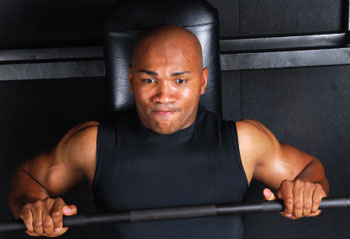Fitness fan found dead under crushing bench press weights
I’m not sure how a person can be a “fan” of fitness (who is on the team? who do they play against?), but this guy is dead from bench pressing. You may remember that USC Trojan running back Stafon Johnson had a bar fall on his throat while benching; he required surgery to repair the crushing damage on his throat and larynx.
The bench press is the most dangerous lift you can perform. The bar is moving over the sensitive throat and face area, and, as you can see in the article above, people die from doing it. Here are things to keep in mind when doing it:
1. Never use a false grip
A false grip is one in which the thumbs are not wrapped around the bar; Stafon Johnson undoubtedly was using a false grip. . It’s easy for the bar to slip over the edge of the heel of the palm when the thumb isn’t wrapped. Always wrap your thumb around the bar for every pressing movement.
People use the false grip because it puts their wrist in a close-compacted position and feels better, but they do so because they don’t know how to do it right with their thumb wrapped. I’ll do a post on this in the near future. If you’re using a correct grip and there are other people available…
2. Have a good spotter
A spotter is there to prevent the bar from falling on your face and throat. Note that if a false grip is used, and the bar actually drops on you (as it did Stafon), there is nothing that a spotter can do. What they can do is prevent damage on the sternum or abdominal organs if the bar is pinned on the lifter (or obviously prevent the lifter from getting pinned in the first place). If you don’t trust your spotter, then get several to stand on each end of the bar. If you don’t have spotters, then…
3. When lifting alone, never use collars
The idiotic globo gyms don’t understand that if you’re benching alone, and the bar is pinned on you, it’s not easy to get it off. This is where internal organ injuries occur (there have been cases of people not knowing they injured something until the middle of the night when their internal bleeding became problematic). If the plates are un-collared, then it’s easy to slide the weight off of one side and then the other to get un-pinned from the bar. The guy in the article above probably was pinned under the weight with collars on.
But he was also drunk, so it’s probably not a good idea to train or lift when you’ve been drinking. Unless you’re Chris Riley, who at one point drank a six pack and then PR’d on snatch. That is neither here nor there.
Packers backup QB Graham Harrell comes in stronger
Graham Harrell is the backup quarterback for the Green Bay Packers. This off-season he trained at Accelerate Performance Enhancement Center (APEC) to put on 14 pounds of muscle in 18 weeks. The training mostly consisted of active mobility work, rotational power, and strengthening the shoulder girdle.
“The first thing we did was try to break those (mobility) barriers,” Stroupe said. “And then we tried to strengthen his body through rotation. We strengthened the rotator cuff and scapula region. A lot of the same things you’d do with a pitcher, but we did a lot of it in motion because he’s always moving when he’s throwing as opposed to a pitcher.”
He did weight training three times a week and speed training twice a week. Each session started with about 45 minutes of “lunging, stretching, and functional movement”. This is what I’m summing up as “active mobility” work. His weight training had a shoulder emphasis, and it included him using rowing machines and high pulls — even rowing “six plates”.

Whatever they had him do, it made him noticeably bigger to his teammates and coaches, increased the velocity on his passes, improved his foot work, and helped him gain 14 pounds of lean mass. This is important for a professional athlete, especially a quarterback. It’s easy for us as lifters to look at a program and pick it apart because it doesn’t have squats, presses, or power cleans. But high level performers need to be specifically trained to improve their ability at performing at a high level. Furthermore, various sport positions need to be trained differently than other positions. We don’t have Harrell’s program sitting in front of us, but we already know it worked.
There’s a lot of stupid shit out there, and there might even be parts of various programs that we think could be different or better, but let’s not ignore when something has a lot of success. I admire Harrell’s work ethic because some NFL players won’t significantly improve their physical capability year-to-year. When a quarterback is labeled as having a weak arm, the media acts like it’s something he can’t ever improve. I hope Harrell proves them wrong this year.

